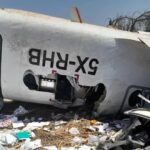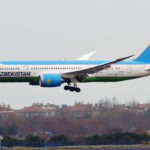This is such a story, which finishes with a happy end and this happy end is surprisingly positive. But then something so unbelievable happens, that the same story becomes a tragedy. Why has nobody ever left a plane, which had landed safely?
It was quite a long time ago – 19 August 1980. It was evening, meaning that Saudi Arabian Airlines Lockheed Tristar was about to take off from the airport in Riyadh, the city in Saudi Arabia. When this Lockheed was entering the market, it was considered as the most modern passenger airplane in the world. The problem is, its debut had been nearly 20 years before the events of the today’s story. Anyway, flight Saudia #SV163 was about to take off with 301 people onboard, including 15 infants. The airplane was supposed to perform a routine regional flight to another city of Saudi Arabia, Jeddah.

Before we’ll move forward, we should mention the pilots of this flight, since the three people seating together in the cockpit didn’t play very nice together. Let’s begin from the captain, who had problems with adapting to quickly changing circumstances. Simply put, he was going mad always whenever things were getting faster. He wasn’t also the best one in making decisions and therefore, he should be neither a pilot nor a commander of anything.
There is also a first officer, but the problem with him is even more serious because he has never finished any flying training. For some reasons, despite failing exams, he had been allowed to fly, without finishing the course. Therefore, it can be said, that this gentleman had some serious gaps in knowledge and should have never seat in the cockpit.

Don’t forget about the flight engineer, who went quite well comparing to his colleagues’ illnesses… with his dyslexia. Each handicap of three crew members was making the decision process much longer and harder, what could end up tragically in dangerous situations.
The dangerous situation occurred unfortunately on August 19. The aircraft’s indicators alarmed about a smoke onboard just 7 minutes after take-off. Obviously, there are certain procedures for such circumstance, but there was a problem – the pilots started to madly look for a control book, consisting of all the procedures. Finally, finding the appropriate chapter, despite their logical deployment, took them over 4 minutes. Also, to this moment on, the pilots didn’t receive any information from the board crew about what actually was happening. Just when the captain went to check the situation personally, he informed his colleagues in the cockpit about the fire, which broke out in the back of the airplane.
Now, we need to mention, that there is no efficient way of putting a fire out in a flying airplane. Especially, there was none in the year 1980. The occurrence of flammable materials was only helping, while the oxygen from the atmosphere was fueling the fire. In the case of fire, which happened to the flight #AV163 the only help was the emergency landing as fast as possible. Anywhere.

However, the Tristar crew had this advantage, that they took off recently and could quite quickly get back to the airport in Riyadh. If everything had gone well and the fire hadn’t spread, the aircraft could land in about 20 minutes. Pilots made a U-turn, but from this moment on, the crew’s actions started to be very chaotic. Also, the passengers were panicking – strong smokiness and visible flames made people onboard mad – they started to run between the rows, trampling themselves and blocking all the evacuation passages.
At the same time, the pilots had their own problems. The fire which had occurred at the back of the aircraft burned through the wire, allowing the control of the engine placed ‘on the tail’ of the airplane – pilots were unable to control its power anymore. Additionally, the flight engineer was continuously reporting the captain with exactly opposite indications – according to him the smoke sometimes was onboard, then was disappearing to appear again after a while. The commander was confused and busy piloting the airplane at the same time. And there was still one problem, that remained unsolved…

Right after the emergency landing, there might be an evacuation of the passengers, but the captain is the one deciding about it. He estimates whether the people are safer inside the airplane (e.g. when the engine burns) or outside of it. Without the clear commander’s decision, the board crew cannot open the door and let passengers out.
Five minutes before the grounding, the head flight attendant asked finally about the evacuation – there was no answer, however. The captain was too busy piloting. The first officer was dealing with radio communication, but he started doing this only after the commander had made him so. Behind them sat the dyslexic engineer, who was deep in thrust, the senseless checking the smoke indicators and the delivery of optimistic comments about the lack of indications – he wasn’t aware apparently, that the airplane was full of smoke.
When the head flight attendant repeated the question in a minute before the landing, but the captain made her come back on her seat. Later, he understood, that there are still some passengers back there and in 30 seconds before the grounding, he made the decision: ‘Tell them… tell them not to evacuate!‘

Actually, it was the most stupid decision to be made in such situation, but there was no time for pondering about it because the burning airplane must have landed finally. And now another quite an unusual thing happened. The fire trucks were ready at the airport, assuming that the airplane will perform a sharp braking. Meanwhile, the aircraft touched the ground, slowly rolled till the end of the runway and tastefully turned into a taxiway… with the engines still working!
The rescue teams started the pursuit, but the aircraft was standing in the same state. Nobody turned off the engines and the doors were still hermetically closed. Pilots were sitting inside, frozen with fear and unable to make any decision. Additionally, the air traffic controllers informed the captain, that they can’t see any flames outside of the aircraft, what only made him even more optimistic, but there was still no decision of the crew.

After three minutes of such waiting for the air traffic controller asked, if the crew either is about to proceed with evacuation or wants to taxi toward the gate. Finally, the captain informed, that he will turn the engines off and begin the evacuation. The very last message came from the airplane 1.5 minute later: ‘we will be now evacuating’. As you can expect, nothing like this happened.
The firefighters also had some problems with getting inside, since nobody had predicted the need of opening the aircraft’s doors from outside. From the moment of landing, it was 30 minutes till the rescuers managed to get inside. Throughout this time everyone onboard asphyxiated with the smoke and nobody has ever left the airplane.

As the investigation showed, all the fire extinguishers onboard were used, but no one, including the pilots, didn’t use the oxygen masks. Meanwhile, the flight engineering was still in his trance after the landing and was calmly switching off all the systems, including the air conditioning onboard. For him, it was the usual landing, apparently.
This is how one of the most shocking aviation stories ends. Although there were many causes put together for the terrifying effect, one seems to be crucial – captain’s incapability to make fast decisions. And on the next week, there will be a story about another pilot and his strong ego.
REMEMBER, THAT AIRPLANES ARE ANYWAY AND STILL THE SAFEST MEAN OF TRANSPORTATION. CRASHES AND SUCH DANGEROUS INCIDENTS OCCUR RARELY ENOUGH, SO WE’RE ABLE TO PRECISELY ANALYSE IT AND PRETEND SIMILAR EVENTS TO OCCUR IN THE FUTURE.





